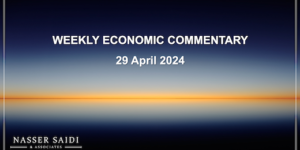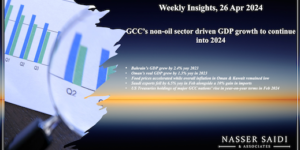Markets
US-China trade fears (ahead of scheduled talks on Oct 10-11already spooking markets, were overshadowed by a bombshell that the Trump administration was considering plans to stop Chinese companies listing on US exchanges, later refuted, while revelations related to and ahead of Trump impeachment proceedings continue to affect market sentiment across the globe: stocks are mostly down for a second week. In the region, Egypt shares crashed at the start of the past week following anti-government protests, erasing almost all 2019 gains but rebounded later, while other markets remained subdued. Among currencies (http://tmsnrt.rs/2egbfVh), the pound slid (after comments from a BoE official that the bank could lower interest rates even if the UK avoids a no-deal Brexit) as did the euro (falling to its lowest since May 2017). Oil prices fell after supply concerns abated on the ahead-of-schedule repairs in Saudi Arabia, and potential Saudi-Houthi ceasefire, while gold prices edged lower. Overall, a very mixed Q3 for assets:https://tmsnrt.rs/2m0Jepv.
Global Developments
US/Americas:
- Q2 GDP growth in the US remained unrevised at a 2.0% annualized ratein its third revision. Business investment contracted by 1% (from the previous reading of -0.6%) while growth in consumer spending was adjusted down to 4.6% in Q2 vs 4.7% earlier reported.
- Core PCE price index increased to 1.8% in Aug, the biggest gain since Jan, and up from Jul’s 1.7%. However, the overall PCE price index was unchanged in Aug as food prices declined for a third straight month and the cost of energy goods and services dropped by 2.0%.
- US Markit manufacturing PMI touched a 5-month high of 51 in Sep (Aug: 50.3). However, export books continue to weaken, and factory conditions remain the worst since 2009. Though the Markit services PMI edged up to 50.9 in Sep (Aug: 50.7), it is one of the lowest in 3.5 years. Separately, the ISM manufacturing PMI showed that business activity had contracted in Aug (49.1, ending 35 consecutive months of expansion).
- Durable goods orders picked up by 0.2% mom in Aug (Jul: +2.0%). Orders for non-defense capital goods excluding aircraft, a proxy for business spending plans, dropped 0.2% mom in Aug amid weak demand (the last negative growth reading was in Apr).
- S&P Case Shiller US national home price index increased by 3.2% yoy in Jul, mirroring the gain in Jun. New home sales accelerated by 7.1% mom in Aug to 713k units, thanks to a shortage of previously owned homes. Pending home sales meanwhile rebounded by 1.6% mom and 2.5% yoy in Aug, supported by falling mortgage rates.
- Initial jobless claims marginally increased by 3k to 213k in the week ended Sep 21, with the 4-week moving average at 212k (-750).
Europe:
- Germany may well be in a technical recession. German composite PMI shrank to 49.1 in Sep for the first time since Apr 2013, and from 51.7 in Aug. The manufacturing PMI reading dived to 41.4, the lowest in more than 10 years. Services activity stayed above the 50-mark, though falling to 52.5 (Aug: 54.8).
- EU growth is limping. The EU’s flash composite PMI fell to 50.4 in Sep (Aug: 51.9); manufacturing PMI fell to an 83-month low of 45.6 in Sep (Aug: 47) while the services PMI fell to an 8-month low of 52 (Aug: 53.5).
- European Commission business climate indicator fell to -0.22 points in Sep from 0.12 a month before. Economic sentiment dipped to 101.7 in Sep – its lowest level since Feb 2015 – from 103.1 in Aug.
- German Ifo business climate index improved to 94.6 in Sep (Aug: 94.3), thanks to a better assessment of the current situation.
Asia Pacific:
- Japan leading economic index increased marginally to 93.7 in Jul (Jun: 93.6) while the coincident index tipped up to 99.7 from 99.5 in the month before.
- Tokyo CPI slowed to a 16-month low of 0.4% yoy in Sep, while the core CPI ticked up by 0.5% yoy thanks to energy-related items. Come Oct 1, consumption tax will be raised to 10% from 8% currently, and the expected impact is likely to be offset by stimulus measures (including free pre-school education).
- Singapore inflation edged up to 0.5% yoy in Aug (Jul’s 6-month low of 0.4%), supported by higher road transport prices, while core inflation remained unchanged at 0.8%.
- Industrial production in Singapore plunged by 8% yoy in Aug – the worst since Dec 2015 – dragged down by the electronics sector. Excluding the volatile pharma sector, factory production fell by 12.4%.
Bottom line:The World Policy Uncertainty Index is at its highest in a 20-year history (https://tmsnrt.rs/2mMclgB) – not surprising given the latest political dramas in the US (impeachment, ongoing confrontation with China) and the UK (Brexit, potential no-confidence vote and possible elections) on one hand, and the trade spats on the other (the unabated China-US wars, US trade tariffs that could hit Europe this week). PMI numbers continue to be depressing reading, though the latest data shows more resilience in the US (for now) than in Europe.
Regional Developments
- Bahrain, in its first dollar bond issue since being bailed out by its Gulf allies last year, raised USD 2bn. It sold USD 1bn of Sukuk, due in 2027 with a yield of 4.5% as well as USD 1bn of conventional notes maturing in 2031 offering 5.625%.
- The Central Bank of Bahrain’s BHD 100mn bond issuance was oversubscribed by 233%.
- Bahrain-India bilateral non-oil trade grew by 24.6% during 2016-2018 to over USD 1.1bn. Bahrain now exports aluminium worth USD 140.3mn to India.
- Egypt’s central bank lowered rates for the second consecutive month, with the latest being a 100bps cut to both the overnight deposit and lending rates to 13.25% and 14.25%.
- Stakes in five or six “large” state-owned enterprises would be offered by end-Jun 2020 in a public listing, announced Egypt’s PM, “to encourage the private sector and citizens to invest”.
- Egypt’s finance minister assured that there would be no increase in tax rates in the currently being drafted income tax law; it will also not include any amendments on tax exemptions.
- Non-oil exports from Egypt grew by 4.6% yoy to USD 1.694bn in Aug, with exports of the Food Export Council up to 197mn.
- Egypt’s key trade partners in H1: bilateral trade with China increased by 4.6% to USD 6.5bn; two-way trade with the US grew by 8% yoy to USD 3.7bn, while US investment in the country was up 5.2% to USD 1.07bn; bilateral trade with the EU was up by 13% yoy to EUR 14.2bn.
- In the Cabinet’s annual report for fiscal year 2018-19, it was revealed that Egypt has become gas self-sufficient after receiving the last LNG shipment in Sep 2018: its LNG exports touched nearly 226bn cubic feet of gas and LNG, valued at around USD 1.2bn, during Jul 2018-Jun 2019. The nation also invested USD 10.2bn in the exploration, development and operation of oil and natural gas during this period. Natural gas output at Egypt’s Zohr field amounted to 2.7bn cubic feet per day (bcfd) in Aug, meeting the target four months ahead of schedule.
- India’s oil imports from Iraq surged to a record high of about 1.32mn barrels per day (bpd) in Aug, up by more than 33% mom and 29% yoy.
- The Central Bank of Jordan lowered interest rates on all monetary policy instruments by 25bps.
- Trade deficit in Jordan narrowed by 10% yoy to JOD 5.1bn during Jan-Jul this year; exports grew by 5.5% to JOD 2.749bn while imports were down by 4.4%.
- Jordan’s public debt increased by 4.2% to JOD 29.5bn by end-Jul this year, rising to 94.4% of estimated GDP. The increase is largely due growing indebtedness of the National Electricity Power Company and the Water Authority, together at JOD 7.4bn.
- Jordan’s finance minister, in a meeting with the parliamentary financial committee, stated that no new taxes would be levied to compensate for the decline in tax revenues this year.
- The value of bonds and related Tawarruq issued by Kuwait’s central bank declined by 6.7% yoy to KWD 6.02bn (USD 19.87bn) in Jan-Sep 2019.
- According to the finance minister, Lebanon has begun preparing to issue a Eurobond of around USD 2bn in Oct to meet financing needs. Separately, the Central Bank governor, trying to allay market jitters, stated that interest rates on Lebanese bonds traded on secondary markets were inflated and also assured that Lebanese banks were meeting customer demand for US dollars.
- About 35% of the 1.7mn+ tourists into Oman during H1 this year were GCC nationals. Indians (12%), German (6%), British (5%) and Chinese (2.8%) rounded up the top visitors.
- Output from Oman’s oil refineries grew by 2% at end-Aug 2019 while diesel production declined by 6%.
- Promoting tourism – Saudi Arabia announced the issuance of on arrival tourist visas: for the first time, visitors from 49 countries will be able to apply for e-visas online or get them on arrival. Foreign women, above 24 years of age, will be allowed to travel without a male and can be dressed in “modest clothing” (easing the strict dress code). Aiming to promote tourism, the General Investment Authority and Saudi Commission for Tourism and National Heritage have agreed partnerships with regional and global investors worth SAR 100bn+ (USD 26.6bn). By 2030, tourism is estimated to contribute up to 10% of Saudi Arabia’s GDP, versus just 3% now.
- Reuters reported that Saudi Aramco, via the banks appointed to handle its IPO, was directly reaching out to sovereign wealth funds(UAE’s ADIA, Mubadala, Bahrain’s Mumtalakat, Singapore’s GIC and others) to invest in the domestic leg of the listing.
- It was reported late last week that Saudi Arabia had restored oil production capacity to 11.3mn barrels per day (bpd), a faster than expected recovery after the Sep 14 attacks. Saudi Arabia’s crude exports fell post-attacks: it averaged 5.875mn bpd in the 10 days since the attacks, down 1.494mn bpd from shipments in the first 13 days of the month, according to tanker-tracking firm Petro-Logistics, reported Reuters.
- CPI in Saudi Arabia declined by 1.1% yoy in Aug, registering the 8th consecutive month of deflation. The decline was largely due to a 6.5% drop in housing and utilities.
- Saudi Arabia’s exports to China, Japan, India, South Korea and the US together accounted for 50.9% of total volume of exports in 2018. Exports to these nations grew by 36% to SAR 562.3bn.
- Total assets and liabilities of commercial banks in Saudi Arabia increased by 5.2% yoy to SAR 2.433trn in Q2 this year, according to SAMA data. Deposits grew by 3.9% to SAR 1.677trn in Q2.
- About 712k+ non-Saudi workers will benefit from Saudi Arabia’s decision to waive fees for expat workers in industrial institutions – starting Oct 1st this year, for five years.
- Sovereigns and corporates from the MENA region have raised around USD 85bn this year from dollar and euro bond issuances, with Saudi Aramco and Qatar the biggest issuers.
UAE Focus
- The UAE central bank revised upwards its growth estimate for this year to 2.4%, supported by growth in the oil sector (+5%) while the non-oil sector will grow only at 1.4%. UAE grew by an estimated 2.2% in Q2, with non-oil GDP growth at 1.5%
- Total credit disbursed to micro, small and medium enterprises in the UAE amounted to AED 88.7bn by end-Q1 this year. This accounts for 11% of loans to the corporate sector and 5.8% of total bank credit during the period.
- Remittances from the UAE fell by 8% yoy to AED 80.96bn in H1 this year, according to the central bank. Indians (37.2% of total), Pakistanis (10.5%) and Filipinos (7.2%), Egyptians (6.3%) and UK citizens (3.8%) were the top remitters in Q2.
- Employment in the UAE private sector increased by 1% in Q2 to 5.1mn compared to Q1’s 0.1% growth. Construction and real estate sector together account for 45.7% of total employment. Interestingly, H1 witnessed an increase in net new work permits issued: growth more than doubled for clerks (121.6% yoy), as well as blue collar skilled (+549.7%) and unskilled labour (+376.3%) though professionals and technicians work permits declined compared to a year ago. Wages dipped across the board in Q2, with the highest declines among unskilled labour (-19.1% ytd) and managers (-2.3% ytd). (More details: https://www.centralbank.ae/sites/default/files/2019-09/QER%20Q2%202019%20-%20English.pdf)
- Abu Dhabi sold USD 10bn of bonds in its first international deal in two years. The emirate sold USD 3bn of five-year fixed notes (at yield premium of 65bps more than Treasuries of similar maturity), USD 3bn of notes due 2029 (at a spread of 85 bps) and USD 4bn of 30-year notes (at 110bps).
- UAE’s consolidated government expenditure increased by 21.6% yoy to AED 119bn (USD 32.4bn) in Q1 this year. Revenue growth also eased during the quarter (-0.9% yoy) largely due to a decline in tax revenues (-9.3% yoy to AED 42.4bn).
- Dubai’s Department of Economic Development issued 2,650 new licenses for various professional, commercial, industrial and tourism activities in Aug 2019. Real estate, leasing and business services accounted for 43.9% of the new licenses issued.
- A new law to regulate the joint ownership of real estate in Dubai requires developers to submit all necessary documents of jointly owned real estate projects to the Dubai Land Department within 60 days of the completion date. Separately, DLD disclosed a 134% increase in real estate transactions following the creation of the new Higher Committee of Real Estate on Sep 2. The value of real estate investments crossed AED 56bn this year across 31k investments by 23k investors.
- A new Emiritisation plan has been approved for Dubai: the program which focuses on 12 specific skills, also includes 5 pillars – identifying and analysing the job market, education systems and skills, work programmes, information and vocational guidance and policies and legislation.
Media Review
Four Collision Courses for the Global Economy
https://www.project-syndicate.org/commentary/playing-chicken-with-global-economy-trump-china-iran-argentina-by-nouriel-roubini-2019-09
What People Say About the Economy Can Set Off a Recession
https://www.nytimes.com/2019/09/12/business/recession-fear-talk.html
Climate change could cause a new mortgage default crisis
https://www.ft.com/content/7ec25f94-e04f-11e9-9743-db5a370481bc
U.S. Treasury: There are no current plans to block Chinese listings
https://t.co/EXMLyKLnn2
Powered by:







